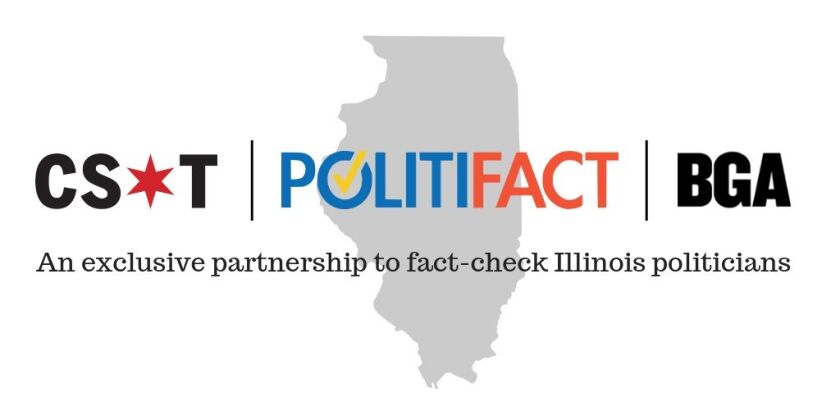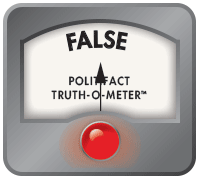Calling for restrictions under the state’s stay-at-home order to be relaxed in his west-central Illinois district, Rep. Darin LaHood claimed Chicago accounts for the vast majority of the state’s COVID-19 cases.
“Peoria is not like Chicago,” LaHood told a CBS affiliate in Peoria. “Ninety-three percent of the cases in the state of Illinois have come from Chicago. … There has to be a tiered system, a more measured and a balanced approach.”
LaHood, a Republican who represents Illinois’ 18th Congressional District, which includes Peoria, made those remarks May 1 after Democratic Gov. J.B. Pritzker acknowledged some regions may be ready to reopen sooner than others depending on when they pass their peak.
While there’s no doubt major urban centers with large, concentrated populations have seen a higher number of confirmed positive cases, LaHood’s figure for Chicago — where about 20% of the state’s 12.7 million residents reside — seemed improbably high.
On the day he made his claim, the number of cases in Chicago had reached 22,700, about 40% of the state’s 56,000 cases at the time, according to data from the Illinois Department of Public Health. Chicago’s share of the total hasn’t varied much in the days since, the same dataset shows. LaHood’s own Peoria County has seen just 148 positive cases.
Debates over how and when to resume different kinds of business and other activities have raged across states as the nation continues to confront both a rising death toll and historic surges in unemployment.
Pritzker has since released a plan to gradually reopen Illinois that divides the state into four regions. None of the counties LaHood represents are included in the same region as Chicago. Some businesses, such as restaurants, would not open anywhere until the end of June at the earliest under the plan. LaHood said it’s “unrealistic” for downstate regions to wait that long.
When we asked LaHood’s office for evidence of his claim, a spokesperson indicated LaHood was referencing an area that included Chicago and the northern part of the state.
“Northern or upstate IL and Chicago, as of last week, accounted for approximately 93% of the cases, and ‘Northern’ was inadvertently left out during the interview,” a spokesman wrote in an email.
Asked if LaHood misspoke when he cited Chicago instead of “upstate” or “northern” Illinois, we got no response.
Had LaHood referred to counties in northern Illinois that include the Chicago metropolitan region, he would have found himself on much firmer ground. The vast majority of the state’s cases have occurred in Cook County and the five counties that surround it: DuPage, Kane, Lake, McHenry and Will. Together, those six counties are home to about two-thirds of Illinois residents but accounted for 90% of the state’s COVID-19 cases as of May 13.
It’s common for residents outside of the Chicago area to refer to the significantly larger and more populous northeastern region collectively as “Chicago,” according to state political experts. But they said that inaccuracy reinforces regional stereotypes.
“If you’re already disposed to think of things as us versus them, then that’s reinforcing that narrative,” said Kent Redfield, a professor emeritus of political science at the University of Illinois Springfield. “But it’s not precise, it’s not accurate. … If you’re referring to northeastern Illinois, then be specific about what you’re referring to.”
Our ruling
LaHood said 93% of COVID-19 cases in Illinois “have come from Chicago.”
Confirmed cases in Illinois’ largest city account for less than half of the state’s total cases, public health data show. That’s far from the figure LaHood cited during his TV appearance.
LaHood’s spokesperson said he was referring to the northern region of the state more broadly, but experts told us that’s no excuse.
We rate his claim False.
FALSE — The statement is not accurate.
Click here for more on the six PolitiFact ratings and how we select facts to check.
The Better Government Association runs PolitiFact Illinois, the local arm of the nationally renowned, Pulitzer Prize-winning fact-checking enterprise that rates the truthfulness of statements made by governmental leaders and politicians. BGA’s fact-checking service has teamed up weekly with the Sun-Times, in print and online. You can find all of the PolitiFact Illinois stories we’ve reported together here.
Sources
WMBD-TV clip tweeted by U.S. Rep. Darin LaHood, May 4, 2020
LaHood tweet, May 11, 2020
Restore Illinois plan, Office of Gov. J.B. Pritzker, May 5, 2020
COVID-19 statistics, Illinois Department of Public Health, accessed May 5 & May 13, 2020
Email correspondence: John Rauber, LaHood spokesperson, May 6, 2020
Phone interview: Kent Redfield, professor emeritus of political science at the University of Illinois Springfield, May 13, 2020
Phone interview: John Jackson, political scientist and visiting professor at the Paul Simon Public Policy Institute at Southern Illinois University Carbondale, May 13, 2020
Phone interview: Christopher Mooney, professor of state politics at the University of Illinois Chicago, May 13, 2020
Phone interview: Mike Lawrence, former director of the Paul Simon Public Policy Institute at Southern Illinois University Carbondale, May 13, 2020








